How to set SMART goals (+ examples and templates)
Last updated on: June 29, 2023
We all have goals — to be more successful in what we do, to enroll in a university, improve our skills — the list goes on. Goals are what sets thriving people apart from everyone else.
As Norman Vincent Peale, an advocate of the positive thinking movement, once said:
“All successful people have a goal. No one can get anywhere unless he knows where he wants to go and what he wants to be or do.”
But are your goals always worth pursuing?
Are your goals always even possible to achieve?
Are your goals tangible?
Those are all difficult questions that often surpass our ability to answer in a straightforward, systematic, and logical way.
Luckily, I’ll offer simple criteria you can use to determine the value of any goal — they’re called SMART goals.
In this guide, I’ll also lay out the answers to the following questions:
- What are SMART goals exactly,
- How and when to set SMART goals, and
- When SMART goals are not that smart.
As a bonus, I’ll give you a few SMART goal templates to use in your work and life and touch on how to write SMART goals you’ll stick to.
Let’s get rolling!

Table of Contents
What is a SMART goal?
The acronym SMART stands for 5 characteristics of a goal that you should consider to be able to achieve the goal successfully. Each characteristic is represented by 1 letter in the SMART abbreviation:
- S stands for Specific — specific goals are straightforward, precise, and can be easily defined.
- M stands for Measurable — measurable goals constitute points of reference you can use to assess whether you are successful in progressing toward or reaching the said goal.
- A stands for Attainable — attainable goals are realistic in the sense that you have a reasonable amount of time, money, and skills to reach them.
- R stands for Relevant — relevant goals hold particular importance in your life, the project you’re currently working on, or your business as a whole.
- T stands for Time-bound — time-bound goals “bind” you with a specific time frame you’ll have to work on to call your efforts a success.
In other words, SMART goal setting helps you elaborate your aims and desires — and make an action plan. In fact, setting SMART goals increases the possibility of achieving your goal.
Interestingly, SMART goals are also known as SMART criteria or SMART objectives, too. But no matter your SMART goals definition, don’t pass on this opportunity to make them part of your routine.
For an illustration of SMART goals, take a look at my example of cutting time for processing data in Excel below:
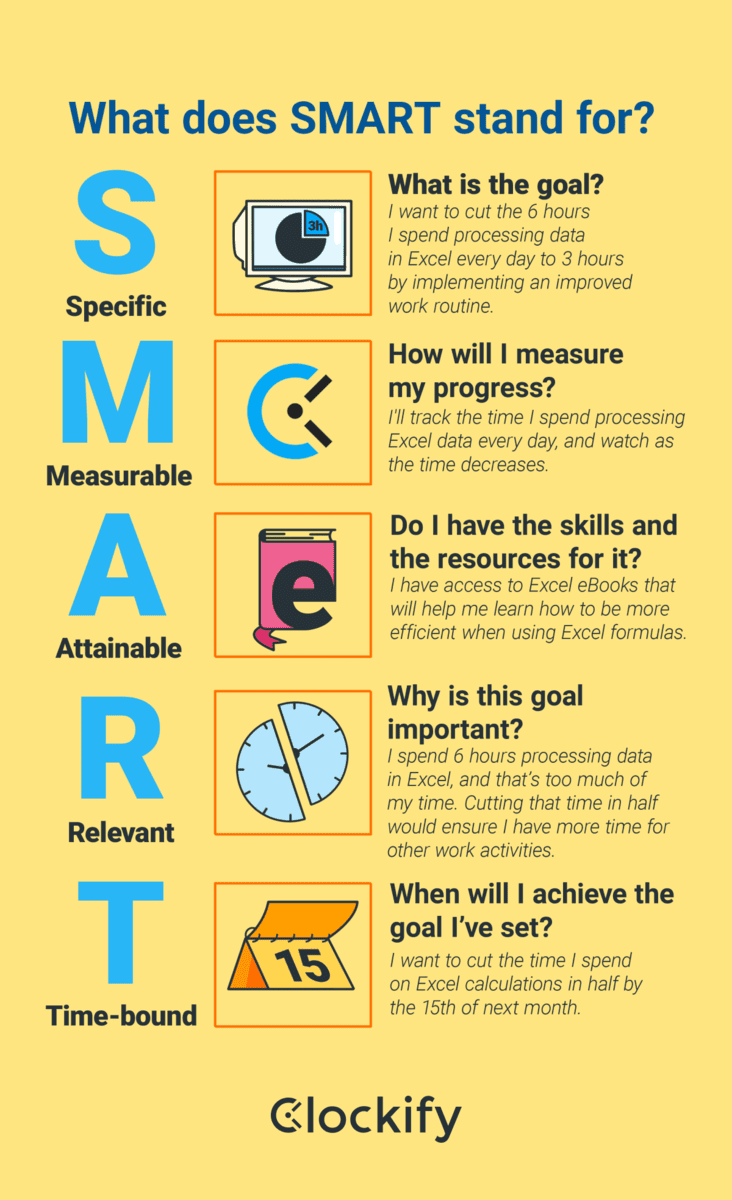
How to write SMART goals?
By now, you might wonder, “How do I write a SMART goal and how do I apply this framework to real-life scenarios?”
I’m glad you asked!
The application of SMART goals varies. In any case, you can use these criteria to decide whether your specific career goals are worth pursuing or if working on particular areas of your personal development would be beneficial enough.
To help you wrap your head around the matter, here are 5 critical steps to follow on your SMART goals journey. Let’s get started!
Step #1: Make goals specific
Specific goals are well-defined and precise enough so that you won’t steer away from achieving them.
Let’s take a look at an example.
If you say that you want to be in marketing, that’s a nonspecific goal.
It’s what you usually say to your extended family when you want them to stop bugging you about when you’ll get a job. Again, it sounds nice, and it may even impress your grandparents — but it’s too broad to motivate you to act on it.
On the other hand, suppose you say you want to land the position of a Junior Marketing Specialist in a Boston tech company. Now, that’s a well-defined, specific goal you can strive for.
Let’s look at a few prompts to use when crafting your SMART goals.
Questions for specific goals
If you want to make a goal specific, consider answering a few questions. You don’t have to answer all of them, but the more questions you answer, the more specific your goal gets.
Here they are:
- Q1: What is the goal?
- Q2: What are the details of the goal?
- Q3: What do I want to accomplish with it?
- Q4: Who is involved?
- Q5: Where is it going to happen?
- Q6: What resources are available?
Examples of answers that prove the goal is specific:
- A1: I want to land a Junior Marketing Specialist position.
- A2: I want to apply for 10 job calls each week during the month. At this rate, I’ll land a job faster.
- A3: I want to feel financially stable, enjoy my work more, and generally feel better about myself.
- A4: I’m the chief person responsible for getting the job. Still, I’ll also talk to a few mentors and industry peers to learn how to land a good position.
- A5: I’ll spend a bit more time online, researching and applying for jobs. I’ll look at job boards, famous freelance websites, and other online places.
- A6: I’ll have advice from my mentors and the network I’ve established over the years. Also, I’ll ask previous employers to write me recommendation letters.
Step #2: Make goals measurable
Measurable goals consist of specific milestones with clearly defined criteria that help you track your progress on your way to achieving them.
For example, if you just say that you’ll study for your Monday math exam, you might not be actually able to follow through with this plan.
When you define your goal without a specific, actionable plan, you don’t have any distinguishable milestones to help you stay on track.
But let’s assume you say that you’re going to study for your math exam for 5 hours each day, leading up to the next to the last day before the exam when you’ll revise everything. Now, that’s a measurable goal with clear milestones and a plan you can follow (and a plan you can stick to).
So, let’s explore 3 questions and 3 answers of measurable goals.
Questions for measurable goals
If you want to make a goal measurable, consider answering the following questions:
- Q1: How will I measure progress?
- Q2: Do I have the necessary tools to measure my progress?
- Q3: How will I know the goal has been accomplished?
Examples of answers that prove the goal is measurable:
- A1: To measure my progress (or lack thereof), I’ll check in with my goal tracking app of choice to see how much time I spent studying for the math exam.
- A2: I’ve recently subscribed to the Clockify goal tracker to track my progress daily. Also, I’ve set a clear learning goal with areas where I expect improvements, like algebra, geometry, and arithmetic.
- A3: Simple math will tell me whether I have accomplished my goal. If by next Monday, my time tracking app shows that I’ve spent 5 hours a day reading, studying, and learning for the math exam, I’ll consider it a success.
💡 Clockify Pro Tip
Whatever SMART goal you set, you should measure and keep track of it with a fitting tool. Here’s the definitive list of the best goal tracker apps you can use for this purpose:
Step #3: Make goals attainable
Attainable goals are realistic enough for you to successfully reach them.
Saying that you’ll lose 30 lbs in 1 month is usually not attainable.
In fact, you can expect 2 outcomes that can come from such an overachieving goal — and neither is favorable:
- You go on a strict diet and exercise routine. You stick to your diet without faltering and exercise hard every morning. But, ultimately, you fail because losing that much in such a short time is near impossible.
- You feel discouraged by such an unfeasible goal from the start. So much that you give up without even trying.
On the other hand, saying that you’ll lose 3 lbs every week for a month by eating healthier and exercising regularly is attainable.
With such a reasonable goal, you’ll have the best chance to stay motivated throughout it.
Next, let’s dive into 5 questions and 5 answers of attainable goals.
Questions for attainable goals
To make your goal more attainable, answering the following questions might help:
- Q1: Do I have the financial capacity to accomplish my goal?
- Q2: Do I have the skills and willpower to accomplish my goal?
- Q3: Will I have access to help when needed?
- Q4: Do I have all the necessary resources?
- Q5: Do I have the time to accomplish the goal?
Examples of answers that prove the goal is attainable:
- A1: I have enough money to join a gym and consult with a professional trainer.
- A2: I’ve previously already lost 13 lbs within a month on a different occasion. As a result, I firmly believe I can do it again.
- A3: I’ll have access to a personal trainer, helpful advice from my nutritionist friend, and additional support from my family.
- A4: I have all the necessary resources at hand, as my city has several great gyms. I also have an enviable selection of healthy food in the neighborhood supermarket.
- A5: Considering that I work remotely 5 days a week and my job comes with flexible working hours, I can spare 1 hour per weekday to go to the gym — and I have enough time to prepare healthy meals. I can easily spare even more time for the gym and food preparation on weekends.
Step #4: Make goals relevant
Relevant goals are the ones that directly impact your progress and are particularly important to you.
So, to actually stick to your goals till the finish line, you need to make sure your goals are relevant.
Say you want to major in economics. That sounds relevant and worthwhile, right?
However, you’re not the least bit interested in economics. In fact, you don’t plan on pursuing a career in economics.
That right there makes it an irrelevant goal, as it’s not clear what you’ll get in life by working toward it. Of course, apart from gaining a college degree. But you could also get a degree by studying something you like.
As you might have guessed, it’s always best to pursue a college education in a topic that interests you. A college education goal may also be relevant if you pick a potentially profitable subject you’re not 100% passionate about, but you want to pursue.
Finally, let’s explore 3 questions and 3 answers of relevant goals.
Questions for relevant goals
To make your goal relevant, ask yourself the following questions:
- Q1: Why is this goal important to me?
- Q2: Is this goal worth my time?
- Q3: Is this the right time for it?
Examples of answers that prove the goal is relevant:
- A1: If I get a major in economics, I’ll be more financially secure and have more time to spend on what matters. Also, pursuing a major in economics will make me more confident about myself and my career.
- A2: I feel that getting a major in economics would benefit me in the short and long run. In a nutshell, doing so will affect my mental and physical health. Therefore, it’s worth my time.
- A3: The holiday feasts are over, and it’s time to implement the New Year’s resolutions. As a result, it’s time to pursue that major in economics.
Step #5: Make goals time-bound
Time-bound goals are usually set within a specific time frame, with a clear deadline for their completion.
Take a look at the following example.
To say that you want to participate in a poem writing contest that’s due next week is admirable.
But phrasing it like that means it’s not a time-bound goal.
In this case, the contest has a deadline — say it’s Sunday, February 2. But you didn’t define a deadline for your work. Will you submit your finished work on Tuesday? Or Wednesday? Or 5 hours before the contest deadline, giving you enough time to tweak it to perfection?
As a matter of fact, what’s your time-bound battle plan?
Now, say that you plan to handle the contest by:
- Writing the first draft of your poem on Monday, January 27,
- Revising everything on Tuesday, January 28,
- Finalizing the rhyme scheme on Wednesday, January 29, and
- Sending out the poem on Thursday, January 30 — 4 days before the deadline.
That’s a time-bound goal you can work with. So, let’s dive into a few questions and examples of time-bound goals.
Questions for time-bound goals
To make a time-bound — or timely — goal, answer the following questions:
- Q1: When will I achieve the goal?
- Q2: When will I carry out the activities that will bring me to my goal?
- Q3: When can I expect the first outcomes?
Examples of answers that prove the goal is time-bound:
- A1: I’ll set January 31 as my end deadline. Also, I’ll include daily targets for each of the 3 stages — writing, revising, and finalizing the poem.
- A2: Every day after work, I’ll set aside 2 hours to work on the poem. I’ll make a clear schedule for writing, revising, and finalizing the poem in stages. I’ll check in with my progress every day to see if I’m set to meet the deadline of submitting the poem 4 days ahead of schedule.
- A3: The first outcome I can expect should be completing each stage — writing, revising, finalizing — on a daily basis. For example, if I’ve completed the writing stage, then I can consider my first outcome a success.
Now you know how to set specific, measurable, attainable, relevant, and time-bound goals. Kudos!
Next up, let’s get a few additional tips from business experts and life coaches — with SMART goals examples for work, play, and much more.
How to set SMART goals: Proven tips and expert opinions
If you’ve come this far, setting SMART goals shouldn’t be a problem at this point. But just to be safe, I sat down with a few time management experts, business enthusiasts, coaches, and others to help you understand how to be unstoppable with your SMART goals.
Let’s take a look at unique expert insights into setting and sticking to your SMART goals.
Tip #1: Set a SMART action plan and stick to it
Plans come first, as they are a visual representation of your goals. If you don’t have a plan, you’re more likely to get off track.
But it’s expected that you’ll have more SMART goals than 1. So, I recommend that you:
- Laser-focus on 1 goal in 90-day sprints,
- Spell out each action step in a timeline, and
- Track your progress every week.
I asked Vincent Nair, the CEO of SMARTECH Business Systems, to weigh in on this topic. According to him, setting clear goals will bring you clarity:

“Planning ahead is one of the most effective ways to ensure goals are well-understood, timely and realistic. With a clear schedule and roadmap in place, your entire team will have a better understanding of exactly how, why and when your goals are being set.”
That’s what I call common sense — we truly sometimes need to get back to the basics.
Next, I spoke to Will Yang at Instrumentl, a platform serving grant-seekers. His words were another eye-opener as he said that a SMART action plan must include clear landmarks:

“Ensure apples-to-apples comparisons: it is critical to compare equivalent items and activities when setting SMART goals. For example, if you wish to raise the number of sales calls made in a month, don’t compare it to the number of emails sent in a month. Instead, concentrate on which activity will yield the desired outcomes.”
💡 Clockify Pro Tip
Learn all about how to think about objectives and key results, with additional resources right here:
Tip #2: Serialize your goals and celebrate more
If you’re reading this article, it probably means that you are an overachiever or striving to become one. But one of the main pitfalls overachievers fall into is trying to get more done than they can handle, therefore spreading themselves too thin.
I talked to Alexis Haselberger, time management and productivity coach, to share her wisdom on how to avoid this all-too-common trap. She gives a powerful illustration about how you can feel a sense of satisfaction and motivation if you pace yourself:

“Think of it like reading a book: if you read 5 books all at the same time, and read 5 pages each per day, it’ll take you months to finish them all. But, if you start with one book, and read 25 pages a day, you’ll finish in a couple of weeks, and then can move onto the next — which is much more satisfying and motivating.”
To keep a steady pace means creating a workflow that helps you achieve your SMART goals. Career expert Kaloyan Dimitrov of Enhancv, a resume builder, made a good point when he emphasized the importance of enjoying an occasional treat — your milestones:

“Keep yourself motivated and committed to accomplishing your goals by celebrating the milestones that you reach along the route. Think about treating yourself to something special whenever you reach a significant milestone or accomplish a particular goal.”
In fact, it’s this attitude that allows you to feel a sense of accomplishment and get better results.
💡 Clockify Pro Tip
Speaking of books, read our selection of the best productivity textbooks on the market right here:
Tip #3: Assign people to help you with your goals
Sometimes, you can’t achieve results or accomplish your tasks without the help of others.
For example, it’s possible to lose weight on your own. However, it’s smarter if you pay for a gym membership, and let a professional fitness coach or a nutritionist help you in that process. In reality, it’s easier and safer to listen to professionals with the right skills and knowledge to carry out tasks.
Likewise, you’ve probably heard about the Boomerang effect on gaining weight back quickly after losing it. This usually happens because people starve and lose a lot of weight in a short period. Not only do they lose weight quickly, but muscles as well. As a result, people experience their metabolism slowing down and regain weight again.
Luckily, you can translate this weight loss scenario into any modern knowledge work job, like:
- Writing,
- Editing,
- Designing,
- Coding, etc.
If you’re the editor-in-chief and would like to have a document proofread thoroughly, you don’t need to do it yourself. Instead, ask a fellow editor or writer on your team to do the job for you.
In fact, assigning the right people for the job can result in faster and higher-quality results.
Tip #4: List the tasks that need to be done
Now that you elaborated on your goal in more detail and assigned the right people to assist you, it’s time to focus on the smaller parts. That means the tasks that must be done to achieve the ultimate goal.
In the case of losing 12 lbs of weight, you’ll probably need to complete tasks like:
- Go to the gym every day after work,
- Put aside money for the gym membership and nutrition consultations,
- Weigh yourself each Sunday afternoon, and
- Eat nutrient-rich foods.
Healthy habits coach Stephanie Averkamp weighs in — pun intended — on this topic. Interestingly, she brings home the point on why you should focus a lot more on your behavior in reaching the goal, and not the final goal itself:

“Center your SMART goals around specific behaviors or actions that will take place instead of around specific results you want to achieve. For example, set a SMART goal that is focused on the exercise you will do instead of the amount of weight you will lose. Your behavior is the one thing you have full control over, and behavior drives results.”
When you break your goal into more manageable pieces, you have a better overview of what needs to be done. In turn, the possibility of achieving your goal increases. For that purpose, you can create a hands-on to-do list to keep track of all your tasks in one place.
💡 Clockify Pro Tip
Get as many to-do list templates as you need — from simple to business and personal — right here:
Tip #5: Make a workable schedule
To make sure you accomplish your SMART goals even faster, make work time estimates for each activity or task that you need to complete. What’s more, make use of the time blocking technique to organize your tasks into specific blocks of time.
Let’s move back to the weight-loss example again. One of the key things that you need to strictly follow when losing weight is to pay attention to when you eat your meals.
Even if you are being extremely careful with how many calories you consume daily, eating late at night can decrease your progress and lead to achieving partial results.
For example, one 2022 study by Harvard Medical School researchers found that late-night eating impacts how you spend energy throughout the day. In fact, the research sheds light on the fact that your productivity overall could suffer from irregular eating schedules. Expectedly, all this negatively affects how you work on your goals.
So, to make sure your SMART goal plan runs smoothly, you need to:
- Create a time-bound schedule that you are going to stick to, and
- Determine when your breakfast/snack/lunch/dinner is.
After completing these steps, you’ll see tangible results.
On a similar note, registered dietitian Kelsey Costa thinks that journaling can play a major role in creating a workable schedule:

“Journaling can be a powerful tool for increasing self-awareness, reflection, and the attainability of goals. Journaling helps identify obstacles, patterns, and areas of strength that you may need to draw on during your goal-setting journey. Regularly revisit the specifics of your goals, such as action steps, measurements, and deadlines.”
Now, that’s how you stick to your SMART action plan and goals!
Tip #6: Evaluate and explore
So much valuable advice can sometimes be overwhelming. Yet, many experts have a somewhat curious take on how to approach the SMART goal-setting process.
For example, mental performance coach Lain Lee emphasized that comfort isn’t your ally in reaching your goals:

“Instead of ‘realistic’, your goals should be UNCOMFORTABLE! Nothing worth doing or fighting for is done in comfort! The best things in life — growth, success, learning, love — all exist outside of your comfort zone. So if your goals don’t make you uncomfortable, they’re TOO realistic!”
Another interesting approach in conversations with experts came from certified career and life coach María Tomás-Keegan who showed me a way to enrich the SMART criteria with evaluation and revision:

“2 Additional steps make your SMART goals SMARTER: Evaluate & Revise. Decide when you’ll evaluate your progress and what you’ll look for. This step closes the loop on each goal. Then you’ll know if you need to revise your goal or timeline. This creates a 360-degree view of each goal that helps move them to the finish line.”
In sum, do what works for you — try to make SMART goal setting a seamless process aligned with your personality and preferences.
Remember: You want SMART goals to work for you, not the other way around.
💡 Clockify Pro Tip
Interested in learning more about how your personality type might influence your productivity? Say no more — I got you covered in our blog post with productivity tips:
Why should you use SMART goals?
Even ancient Greek philosophers emphasized the importance of goal setting and proposed that purpose can incite action.
Setting your goals by following the SMART criteria helps you elaborate on them. Similarly, it allows you to see if the goal you want to achieve has any potential or if it’s just a waste of time, as sometimes can be the case.
Up next, I discuss how the SMART goal concept can benefit you insanely in the short run.
Benefit #1: SMART goals enhance well-being
A 2022 study found that SMART goals can increase the likelihood of accomplishing goals and experiencing positive affect. Simply put, positive affect refers to upbeat emotions and expressions in the study’s respondents.
In fact, the same study researchers suggest that the mere existence of a SMART goal strategy increased the quality of the respondents’ behavior that led to goal attainment.
Another relevant result was that the psychologists in charge of the study established that goal attainment, in this sense, led to enhanced well-being.
In summary, SMART goals make it likely that you’ll achieve your goals and that those goals lead to your well-being.
💡 Clockify Pro Tip
Read our detailed guide on how to up your goals game by setting daily targets:
Benefit #2: SMART goals improve time management skills
Setting goals and efficiently managing your time are 2 elements that go hand in hand.
If you look at the acronym SMART again, you’ll see that the terms measurable and time-bound refer to time management. So, when you have a clearly defined goal or goals, you know how and where to focus your time.
What’s more, you can make work time estimates and stick to them to avoid poor spending of resources. Finally, your improved time management skills will help you reduce distractions and increase your focus on more important tasks.
For that purpose, you can opt for a goal-tracking tool like Clockify to get a silent partner in efficiently managing your time and reaching your targets.
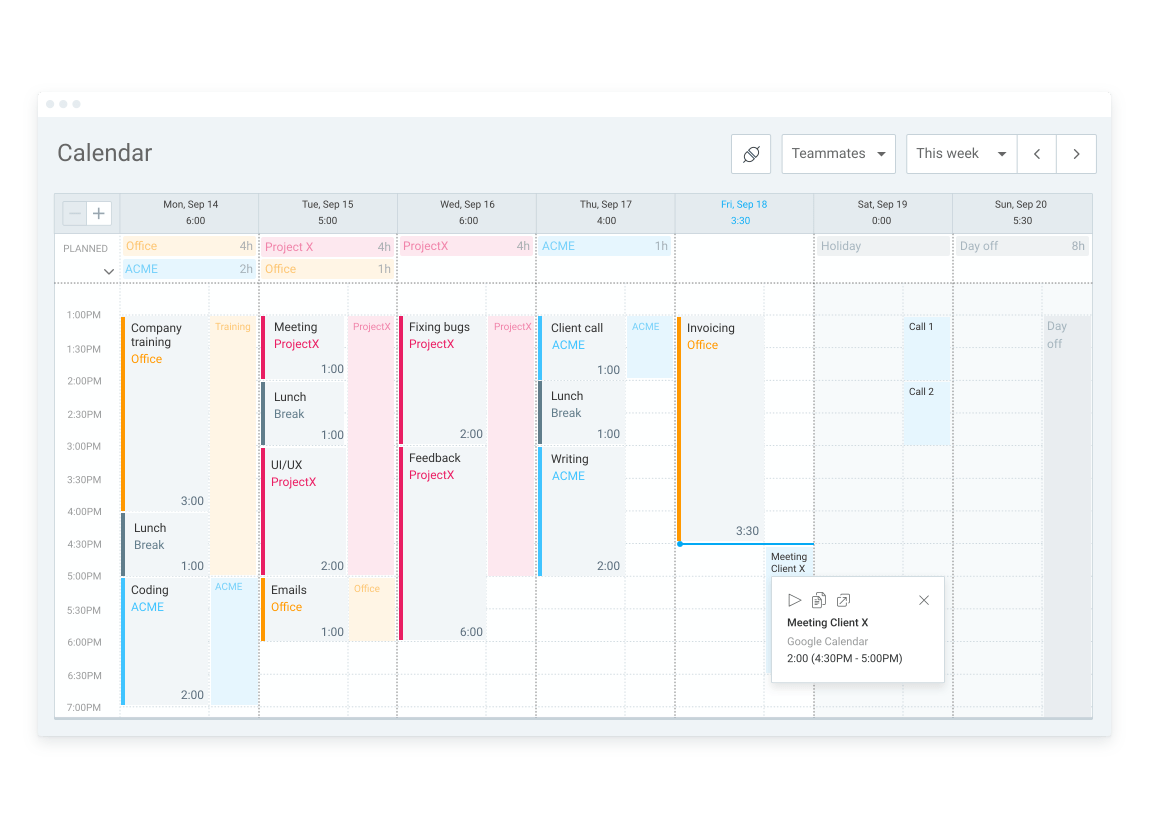
For example, Clockify allows you to beautifully tag and color-code your projects so that you can easily stay on track — and enjoy the process. In fact, the app lets you break down goals into manageable tasks that you can easily digest. In sum, Clockify also allows you to check in on your progress as often or rarely as you want.
By integrating SMART goals into your daily routine (whether work or personal), you’ll never miss a deadline or find excuses for missing your workout again.
💡 Clockify Pro Tip
Learn how to improve your time management skills in our in-depth guide:
Benefit #3: SMART goals increase accountability
To achieve any goal, you need to hold yourself accountable.
I know I’m not reinventing the wheel here, but people often forget to be more responsible on an ongoing basis.
In fact, Harry Morton of Lower Street, a podcast production agency, says something to that effect. Simply put, he told me that you should expect peaks and valleys in how distracted and motivated you feel:

“When working toward a long-term goal, it can be natural to encounter dips in motivation or distractions. An accountability partner can guide you back on track, offering an objective perspective when you deviate from the path to your goals. Be completely transparent and work with someone who understands what motivates you.”
Benefit #4: SMART goals beat workload overwhelm
A little planning ahead never killed anybody — but work overload and workplace stress are taking a toll on people’s health and the economy. According to a research paper by the World Health Organization, anxiety and depression cost the world’s economy $1 trillion each year, mostly due to a decline in productivity.
However, by setting your personal or business goals, you have a clear picture of what needs to be done, when, where, and how. As a result, the likelihood of feeling burned out reduces tremendously.
What’s more, when you clearly identify your SMART goals, you learn how to unshakably say “No” to your colleagues the next time they try to swamp you with work. That’s right: SMART goals will save you from exhaustion and stress.
—
Okay, so now you understand what the SMART goal concept means and why it’s beneficial. Up next, let’s see when SMART goals are the most effective — and when you should avoid them.
💡 Clockify Pro Tip
Find out more about the causes and symptoms of career burnout and how it affects your health right here:
When to use SMART goals
Are SMART goals effective? Yes, when used in the right context.
Here’s when SMART goals work best.
1. Use SMART goals to set priorities
Use the SMART goal criteria when you want to single out your priorities and focus solely on them.
The SMART criteria should guide you in the right direction to get a better insight into what’s important to accomplish something.
In fact, the SMART framework saves you from wasting your time. If you don’t set your priorities right, you’ll lose track of your work. What’s more, you’ll probably end up feeling exhausted — and you don’t want that if you were wondering.
💡 Clockify Pro Tip
Learn why not all tasks are equally important and how you can prioritize them easily:
2. Use SMART goals to set high-level objectives
Use SMART goals when you need to focus on high-level goals that involve a number of smaller, specific tasks. High-level goals (such as advancing your career, enrolling in a university, or losing weight) demand a thorough action plan the SMART goal concept can offer you.
However, I would even argue that SMART goals are especially useful for the more consequential targets in your life — where you need to be on top of your game because the stakes are high. That’s why it’s essential to make SMART goals a part of your everyday life and planning.
For illustration, consider you’re moving into a different town or state and selling your house. If you fail to take into account local taxes, regulations, real estate prices, and transport in your SMART goal framework, achieving this goal could lead to a disaster – personally and professionally.
3. Use SMART goals to tackle work tasks and set mini-milestones
SMART goals help you carry out your ongoing job responsibilities more efficiently and successfully.
In fact, the SMART goal concept helps you split your goal into smaller, more manageable pieces. As a result, you get a clearer insight into the tasks that lead you to achieve the ultimate goal.
For a quick fix, tackle your tasks one at a time to efficiently get them done and avoid being overwhelmed. The technique works wonders!
In fact, the family law and relationship expert, Laura Wasser, thinks that you first need to set mini-milestones to get you going:

“When setting a SMART goal, think of it as a roadmap to your desired outcome. Break your goal into smaller, achievable steps, which will make it easier for you to stay on track and motivated. These mini-milestones will not only keep you focused, but they’ll also give you a sense of accomplishment as you progress.”
💡 Clockify Pro Tip
Read our all-inclusive guide to find out how to break down large tasks into easily digestible pieces:
4. Use SMART goals to handle new assignments
Employ the SMART goal criteria when you’re moving on to new assignments.
Whether simple or complex, the SMART goal concept works well with all types of assignments regardless of their complexity or duration. It shifts your attention to what needs to be done and makes a thorough plan to achieve the final goal.
When you get a new assignment, the first step should be to insert it into one of the upcoming SMART goal templates at the end of this guide. This practice shows you if the assignment is even worth your time and effort — or if it’s a priority.
💡 Clockify Pro Tip
Learn how to distinguish between short-term, medium-term, and long-term plans in your work and life:
5. Use SMART goals for personal development
When you feed the SMART goal criteria into your daily routine, you can make an everlasting, positive change in your life. This way, you can identify areas for improvement and personal growth — and go the extra mile to advance your career.
💡 Clockify Pro Tip
If you want to perform better at your job by following a comprehensive, step-by-step guide, check out this article:
When SMART goals are not so smart
Now, just because it sounds like the smart thing to do — pun intended — that doesn’t mean you should view all your tasks and initiatives through the SMART goals framework.
Take a look at the examples of situations when you should avoid using SMART goals.
1. Don’t use SMART goals to “count” your successes and failures
You shouldn’t use SMART goal-setting just so you can race past your goals as fast as you can without stopping to take a breather and reflect on what you’ve learned along the way.
You also shouldn’t view a SMART goal you haven’t accomplished as a failure and, thus, a reason to judge yourself.
Just because you failed this time doesn’t mean you won’t be able to succeed next time or use the knowledge you gained from pursuing the said goal in the future.
2. Don’t use SMART goals if you tend to give up too soon
SMART goals take time! That’s because they’re more complex than your everyday goals, such as getting to the food store before it closes.
As such, SMART goals take more effort and dedication. Therefore, they can be a bigger challenge for people who get nervous when they think they’re not progressing as best as they could.If you fear that a goal is too large for you to commit to it, it’s best that you reassess it and parse it 1 by 1 into smaller, less challenging goals you can reach easier until you’ve accomplished everything.
3. Don’t use SMART goals when you’re uncertain whether a goal is attainable
Out of all the letters in the SMART acronym, the “A” — which stands for attainable — is the least precise one.
After all, most of the time, you can only be sure a goal is attainable or not if you’ve already tried to pursue it.
So, are you sure you have a shot at landing the position of that Junior Marketing Specialist at that Boston tech company?
Perhaps you don’t have the right qualifications or the right experience.
We’ve seen this before with our example of losing 30 lbs in a month.
Let’s assume you pursue a goal you’ve defined as attainable (despite it, realistically, not being the case). In this case, this action is bound to discourage you when you fail to reach your goal.
Alternatively, you may miss out on some great opportunities if you mark a realistic goal as “out of reach” without properly thinking about it.
4. Don’t use SMART goals when managing a project
According to the Scrum methodology, even though the SMART criteria suggest that a goal should be specific and measurable, other SMART goal criteria can threaten the success of a project, no matter how well you prepare it.
Since a project goes through many stages during its life cycle, some things — like, if a goal is realistic — can’t be predicted in advance without further analysis. Also, the criterion time-bound doesn’t fit with the project management principles either.
You might not be able to know when a goal would be accomplished due to the constant changes during a project’s life cycle.
Therefore, the SMART goal concept doesn’t go hand in hand with project management since it “encourages a simplistic and short-sighted approach to management” — as Scrum methodology experts emphasize in the article I linked to above.
💡 Clockify Pro Tip
Learn about the essential elements of project management and a few tools to get you started:
5. Don’t use SMART goals when you expect a challenge
The SMART goal criteria propose that your goal needs to be attainable. In effect, this means knowing in advance if you have the right skills/knowledge/resources to accomplish something.
When you know that a goal is achievable in advance, it gives you some kind of security. On the other hand, it keeps you stuck in one place. In other words, you are deprived of learning new things or acquiring new skills.
Sometimes, the thrill of the unknown pushes you towards it and makes you realize all the things you can do. So, if you are a thrill-seeker looking for sudden challenges along the way — maybe the SMART goal concept is not the right fit for you.
—Now that you understand when and when not to use them, here are some examples of well-rounded SMART goals you can use to find inspiration. Let’s get rolling!
5 SMART goal examples
By now, you might be thinking: “Enough with the beating around the bush, tell me what’s a SMART goal example, alright!”
I won’t give you 1 but 5 SMART goals examples — how’s that for a treat?
Let’s go through them 1 by 1.
Example #1: SMART goal for improved performance at work
To say, “I want to improve my Excel skills,” is too vague. Instead, try to make your goal:
- Specific: I want to improve my performance with Excel to get a promotion at work. These performance improvements focus on quicker data entry, more efficient calculations, and creating graphs.
- Measurable: I’ll know I’ve succeeded because — by the 1st of next month — I’ll be able to enter my data, complete my calculations through custom and combined formulas, create graphs, and carry out my other work in Excel all on my own, and with minimum effort.
- Attainable: I have enough time to work on improving my Excel skills. I can even enroll in an online course to help me understand some of the finer points.
- Relevant: I like working in my company, and I want to continue working there. One of the preconditions of my staying in the company longer and getting promoted is to streamline my work in Excel.
- Time-bound: I want to perfect my performance with Excel by May 1.
💡 Clockify Pro Tip
Are you familiar with performance improvement plans (PIP)? Check this article out to learn more about how PIPs can boost your work performance:
Example #2: SMART goal for improved time management
Here’s an example of poor goal setting: “I want to accelerate the process of calculating in Excel.”
Instead, your goal should have the following attributes:
- Specific: It takes me 6 hours to implement all the formulas I need to process data in Excel. I want to cut that time to 3 hours per day, at least.
- Measurable: I can track the time I spend handling Excel data every day and then observe how that time decreases day by day and week by week. Similarly, I can work on improving my schedule.
- Attainable: I have the resources to help me learn how to be more efficient when using and combining Excel formulas.
- Relevant: I currently spend 6 hours of an 8-hour workday carrying out calculations in Excel, and that’s too much of my time. Cutting that time in half would ensure I have more time for other work activities.
- Time-bound: I want to cut the time I spend on Excel calculations in half by the 15th of next month.
Example #3: SMART goal for students
Your grades won’t get better overnight, and you sure want to get into a top school or university. Well, saying, “I want to improve my GPA,” won’t do miracles. Instead, make sure your goal is:
- Specific: I want to improve my GPA to 3.8 so I can apply for a semester abroad with a full scholarship.
- Measurable: I’ll need to score an A or A+ on all of my tests this semester to improve my total GPA to an average of 3.8 to qualify for a semester abroad on time.
- Attainable: In recent months, I have fallen behind in school, but I have a history of improving my grades when I put substantial effort into it. So I can improve my grades once again. I’ll need to work longer hours, temporarily cut back on extracurricular activities, and focus on each test and quiz as it comes along.
- Relevant: The school abroad I want to spend a semester at has a great chemistry program. Passing that program will come in handy when I go to college. There, I want to major in chemistry to become a Chemical Engineer.
- Time-bound: I want to improve my GPA to 3.8 by the end of this semester to qualify for a position at the college abroad in question.
💡 Clockify Pro Tip
Students need all the help they can get when it comes to mastering their output. Read our in-depth guide to learn how to radically increase your productivity:
Example #4: SMART goal for leadership and team management
Do you notice a stall in your team’s productivity? Being a team leader can be a double-edged sword from time to time. However, SMART goals can come to your rescue even in this situation.
To help you get started, ensure your goal to boost your team’s productivity is:
- Specific: I want to motivate my team to improve their productivity by 50%.
- Measurable: 50% of increased productivity will trigger a 50% faster project turnaround.
- Attainable: I’ll use team management software and supply my team with the right productivity tools to help them out.
- Relevant: Higher productivity means faster project turnaround, and faster project turnaround leads to satisfied clients. Satisfied clients bring good word of mouth, so we’ll likely land more clients because of it. As a result, team morale would increase, so they’ll feel encouraged to keep up the good work.
- Time-bound: I want to see the expected increase in productivity 6 months from now.
💡 Clockify Pro Tip
Discover more interesting aspects of team management and how it can affect performance right here:
Example #5: SMART goal for weight loss and fitness
You know that I’m-hitting-the-gym-next-Monday attitude never got you anywhere. Most people (including myself) consider going to the gym or exercising in any form as exhausting. In other words, we most frequently see exercise as something that requires a ton of will and determination.
Although it’s not easy, setting a goal based on the SMART goal concept can make it much more bearable and joyful.
Once you are on the right track, you’ll regret missing your workouts, even during public holidays. So, be all ears and ensure that your goal is:
- Specific: I want to lose 10 pounds to improve my fitness and athletic performance.
- Measurable: I want to lose belly fat and be able to endure physical activities without getting tired easily.
- Attainable: Suppose there’s a gym near my building with group fitness classes, indoor cycling, a weight loss program, Pilates, and more. I’m going to try the weight loss program first to lose some fat and later switch to Pilates to form my body shape. Also, I’m going to avoid fast food and late-night snacking.
- Relevant: I like to look nice in my clothes, and physical appearance matters to me. Fast food is high in cholesterol, and high cholesterol runs in my family. As a consequence, I need to be extra cautious.
- Time-bound: I need to go to the gym 3 times a week, go places on foot, and hopefully lose 10 pounds within 2 to 3 months. This is a healthier plan since — if I lose weight in a short time — I will gain it all back eventually.
💡 Clockify Pro Tip
Learn a thing or two about how physical and mental fitness can help you become more productive and reach your goals:
SMART goal templates
Skilfully crafted SMART goal templates and SMART goal worksheets can serve as your quick and efficient generator of — you guessed it — SMART goals.
In the following section, you’ll find different examples of templates, including:
- Leadership SMART goals examples,
- Time management SMART goals examples,
- SMART goals examples for employees,
- Productivity SMART goals examples, and more.
In fact, these SMART goals templates and SMART goals worksheets provide the outline for your SMART goal setting. As a result, you’ll just need to follow the said outline and fill it out with your data. It’s a fast and efficient alternative to creating and following your template or making plans without one.
Basic SMART Goal Template
The first of 10, the Basic SMART Goal Template is a simple yet powerful way to get a bird’s-eye view of your goal.
The straightforward design of this template allows you to easily identify the key components of your goal. If you use the Basic SMART Goal Template, you are taking the first step towards your professional or business goal.
What is the Basic SMART Goal Template about?
The Basic SMART Goal Template is divided into 5 sections, each representing a letter of the SMART acronym:
- Specific,
- Measurable,
- Attainable,
- Relevant, and
- Time-bound.
How to use the Basic SMART Goal Template?
Answer 1 or 2 questions for each section to determine whether the said goal is worth your time. Next, think about if you missed some important aspects and rewrite where applicable.
Who should use the Basic SMART Goal Template?
This SMART goal template is perfect for people who want a simple approach to setting their goals.
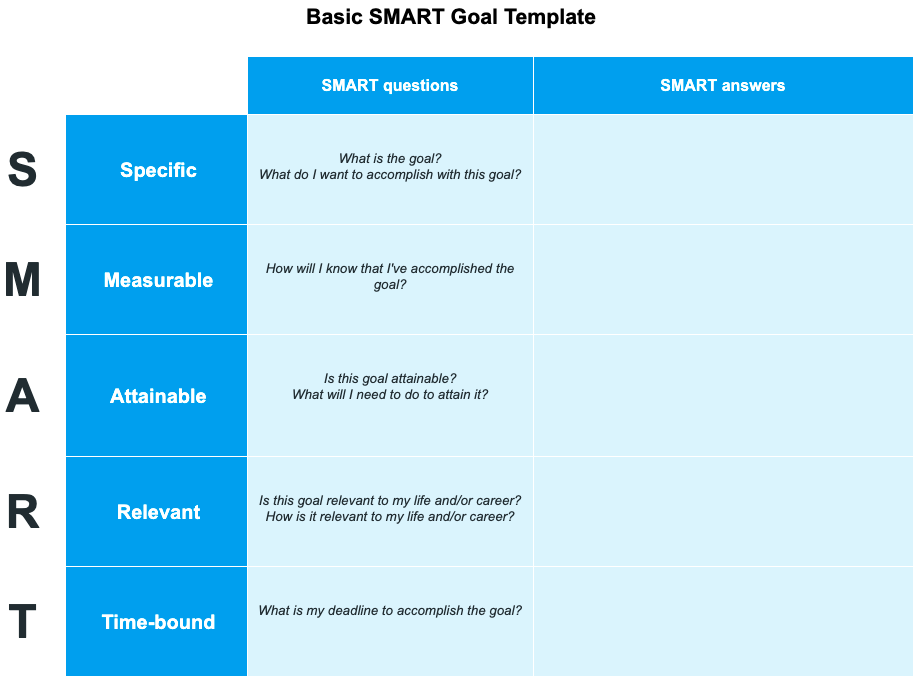
⬇️ Download the Basic SMART Goal Template PDF
⬇️ Download the Basic SMART Goal Template Google Docs
⬇️ Download the Basic SMART Goal Template Excel
⬇️ Download the Basic SMART Goal Template Google Sheets
Basic SMART Goal Template (+ Problems)
The next on our list, the Basic SMART Goal Template (+ Problems) is same as the previous template — just on steroids.
This template is an effective tool for setting and achieving goals. The Basic SMART Goal Template (+ Problems) gives you deeper insights into the resources and persons who may assist you in reaching your goals.
What is the Basic SMART Goal Template (+ Problems) about?
The Basic SMART Goal Template (+ Problems) is divided into 5 sections on 2 pages each.
The first page consists of questions to understand the problems you face. The second page is made up of a cheat sheet that can help you solve those problems.
How to use the Basic SMART Goal Template (+ Problems)?
Answer 1 or 2 questions for each section to determine whether the said goal is worth your time. Next, think about the problems you may encounter as you work toward the said goal — and try to solve them before they happen.
Who should use the Basic SMART Goal Template (+Problems)?
This SMART goal template does wonders for preventing potential problems with your goal (if you want a simple SMART breakdown of your goal). The Basic SMART Goal Template (+Problems) is perfect for businesses and individuals who want to predict financial and organizational issues.
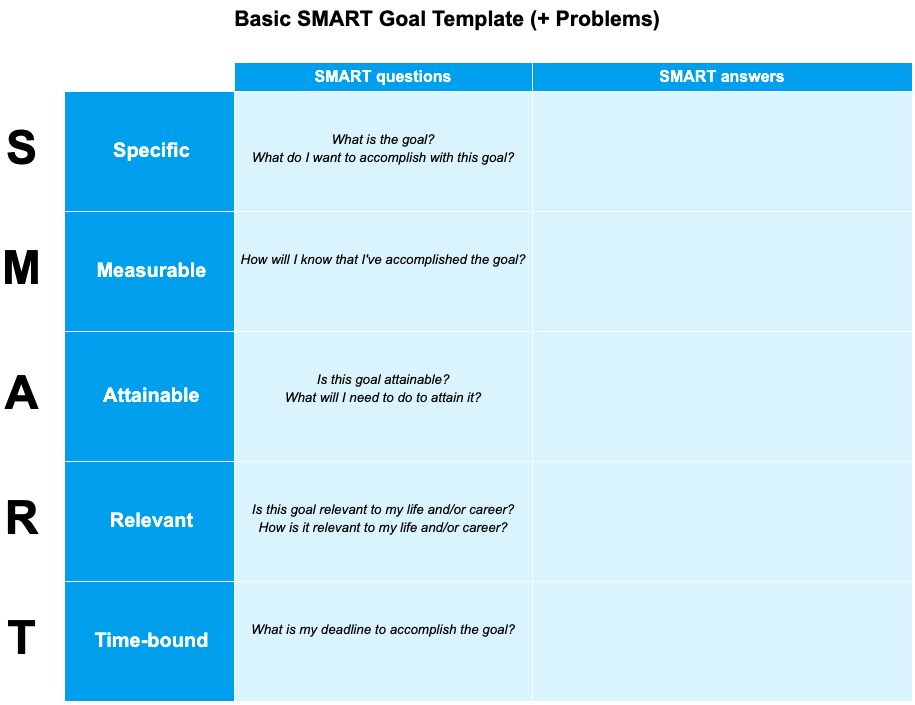
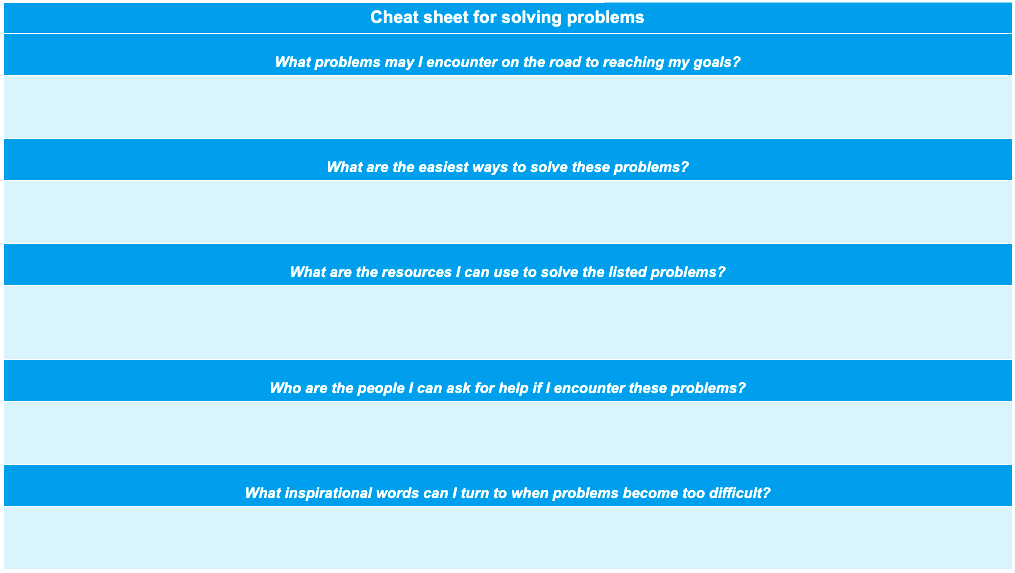
⬇️ Download the Basic SMART Goal Template (+ Problems) PDF
⬇️ Download the Basic SMART Goal Template (+ Problems) Google Docs
⬇️ Download the Basic SMART Goal Template (+ Problems) Excel
⬇️ Download the Basic SMART Goal Template (+ Problems) Google Sheets
Simple SMART Goal Template
The Simple SMART Goal Template is a more relatable and direct template with phrases that anyone can fill out fast.
Yet, it’s fairly simple and can only get you so far. That said, it’s an awesome first step to get you started on setting your SMART goals!
What is the Simple SMART Goal Template about?
The Simple SMART Goal Template lets you determine why you want to pursue your goal — and start planning your goal. It’s a simple illustration of your SMART goal.
How to use the Simple SMART Goal Template?
Answer each question in as much detail as possible. As soon as you’re done, consider if you’ve left out any important information – and add it accordingly.
Who should use the Simple SMART Goal Template?
This SMART Goal Template is perfect for people who want to set SMART goals but don’t necessarily want to answer to SMART criteria.
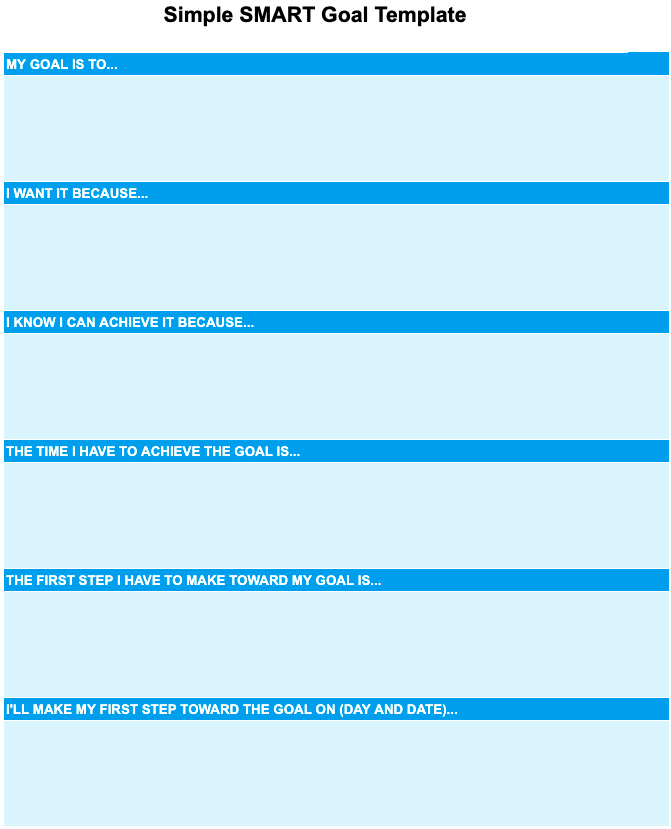
⬇️ Download the Simple SMART Goal Template PDF
⬇️ Download the Simple SMART Goal Template Google Docs
⬇️ Download the Simple SMART Goal Template Excel
⬇️ Download the Simple SMART Goal Template Google Sheets
Elaborate SMART Goal Template
The Elaborate SMART Goal Template guides you through your thought process with in-depth prompts.
This template takes you beyond superficial goal-setting. In other words, the Elaborate SMART Goal Template digs deeper into your potential, desires, and plans.
What is the Elaborate SMART Goal Template about?
The Elaborate SMART Goal Template is divided into 5 sections, each representing a letter of the SMART acronym:
- Specific,
- Measurable,
- Attainable,
- Relevant, and
- Time-bound.
How to use the Elaborate SMART Goal Template?
After downloading your preferred template, answer a detailed list of questions for each section to determine whether the said goal is worth your time. You may also need to tweak your answers as you go, and that’s totally fine.
Who should use the Elaborate SMART Goal Template?
This SMART Goal Template is perfect for people who need more pointers on whether the goal they want to pursue is SMART or not.
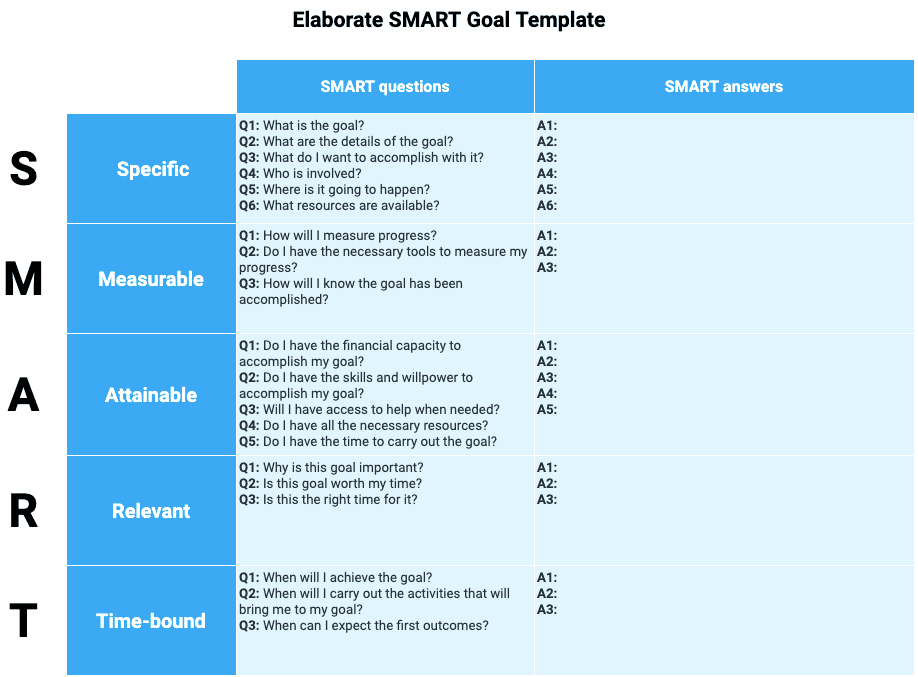
⬇️ Download the Elaborate SMART Goal Template PDF
⬇️ Download the Elaborate SMART Goal Template Google Docs
⬇️ Download the Elaborate SMART Goal Template Excel
⬇️ Download the Elaborate SMART Goal Template Google Sheets
Elaborate SMART Goal Template (+ Problems)
The Elaborate SMART Goal Template (+ Problems) is a helpful tool to establish problem areas and solve each.
The template contains useful prompts on resources and people you can check in with to help you reach your goals faster.
What is the Elaborate SMART Goal Template (+ Problems) about?
The Elaborate SMART Goal Template (+ Problems) consists of 5 sections on 2 pages each.
The first page features a series of questions of the SMART framework. In contrast, the second page consists of a cheat sheet for solving problems you established on the first page.
How to use the Elaborate SMART Goal Template (+ Problems)?
Answer a detailed list of questions for each section to determine whether the said goal is worth your time. After that, think about the problems you may face as you work toward the said goal — and try to solve them before they happen.
Who should use the Elaborate SMART Goal Template (+ Problems)?
This SMART goal template is great for preventing potential problems with your goal — in case you want a more detailed SMART breakdown of your goal. The Elaborate SMART Goal Template (+ Problems) is perfect for businesses and individuals who want to explore financial and organizational concerns in depth.
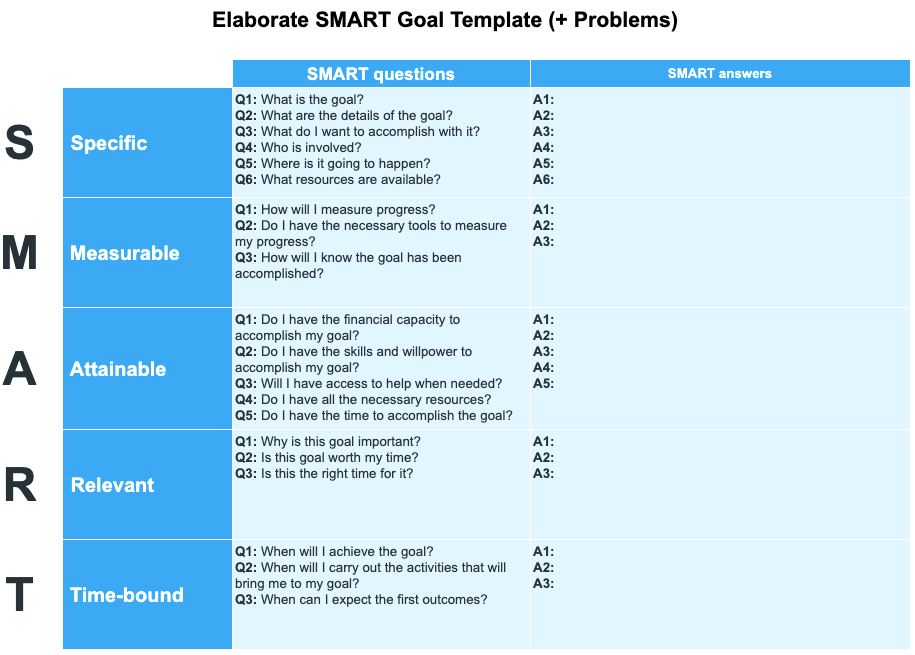
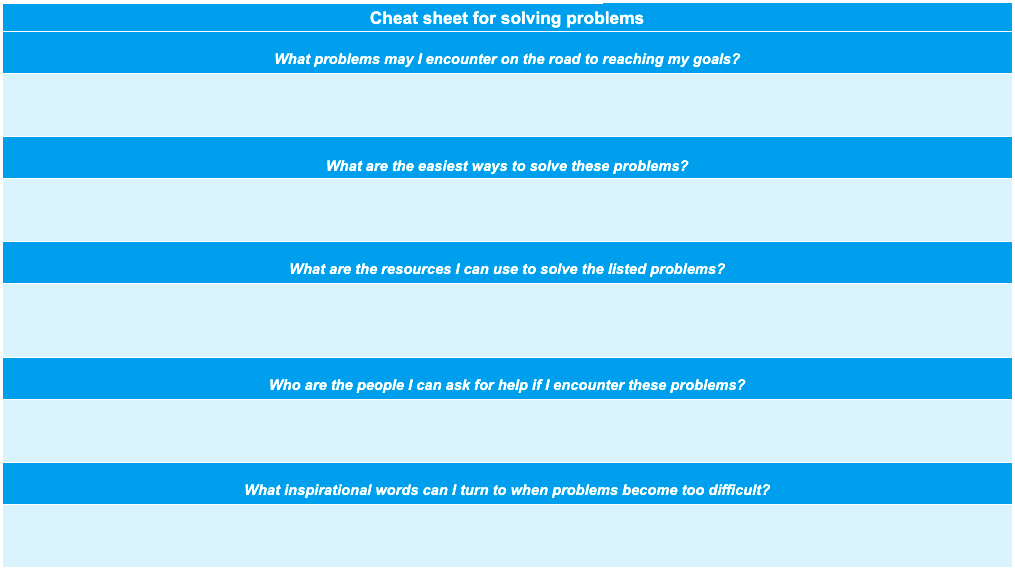
⬇️ Download the Elaborate SMART Goal Template (+ Problems) PDF
⬇️ Download the Elaborate SMART Goal Template (+ Problems) Google Docs
⬇️ Download the Elaborate SMART Goal Template (+ Problems) Excel
⬇️ Download the Elaborate SMART Goal Template (+ Problems) Google Sheets
SMART Goal Tree Template
The SMART Goal Tree Template is a nugget of gold on our list of SMART goal templates.
It’s a treasure trove of valuable insights and direct measurement tools to reach your goals in an efficient and effective manner.
What is the SMART Goal Tree Template about?
The SMART Goal Tree Template helps you select and track Key Performance Indicators (KPIs) that tell you how well you’re progressing with your goal.
How to use the SMART Goal Tree Template?
To use this more complex template, set up at least 3 indicators for your goal. Then, insert measures to track progress, and reach the targets.
For example, the overall goal could be: “Improved customer satisfaction by 50%.”
An indicator for this goal would be: “The number of calls, requests, and emails taken by customer support and ending in happy resolutions.”
The 2 measures we can use to calculate the indicator could be:
- “Professionally and cheerfully handling customer requests, calls, and emails,” and
- “Creating an incentive system for customer support agents to be better in their job”.
Finally, the 2 targets for each measure could be:
- “50% more calls/emails handled more professionally and cheerfully by customer support,” and
- “Managers in the customer support team giving positive employee reviews weekly”.
Who should use the SMART Goal Tree Template?
You can use this template to measure success in various business areas, such as:
- Customer support,
- Company finance,
- Internal processes, and more.
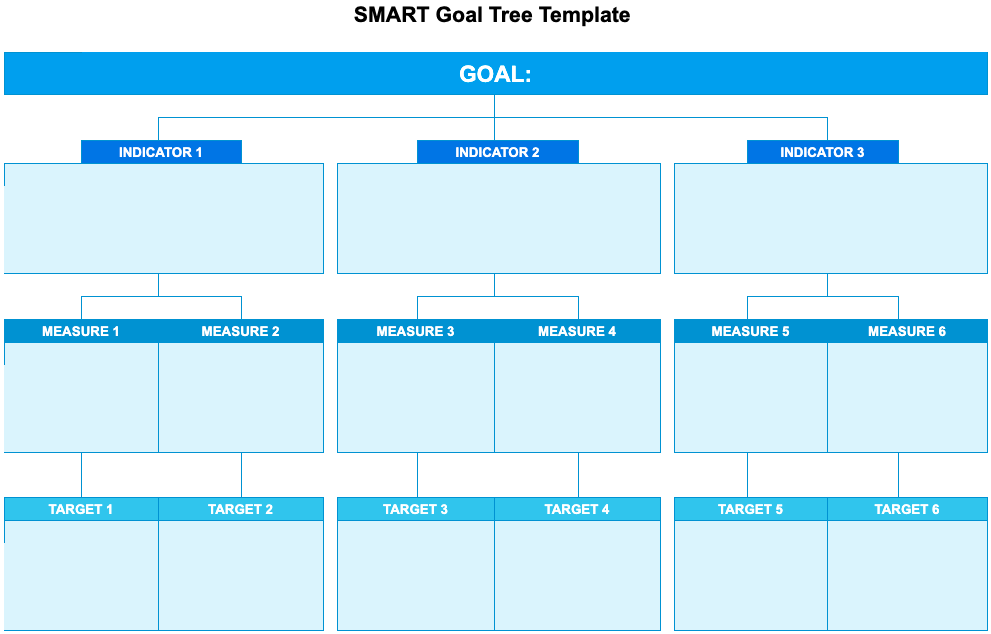
⬇️ Download the SMART Goal Tree Template PDF
⬇️ Download the SMART Goal Tree Template Google Docs
⬇️ Download the SMART Goal Tree Template Excel
⬇️ Download the SMART Goal Tree Template Google Sheets
SMART Action Plan Template (+ Action Steps and Responsibilities)
The SMART Action Plan Template (+ Action Steps and Responsibilities) is just what it sounds like.
This template calls for responsibility and sets out steps on your way to reaching your professional and personal goals. In fact, it gives you immediate feedback on whether you’ve reached your objectives in the end.
What is the SMART Action Plan Template (+ Action Steps and Responsibilities) about?
The SMART Action Plan Template (+ Action Steps and Responsibilities) lets you determine the value of a goal by asking you to explain how or why the said goal is:
- Specific,
- Measurable,
- Attainable,
- Relevant, and
- Time-bound.
Then, you can add the person responsible for the said goal and lay out the steps you need to go through to reach success.
How to use SMART Action Plan Template (+ Action Steps and Responsibilities)?
After downloading this action plan template, respond to each prompt and fill out the steps you need to complete to reach your goal. Also, you can name the responsible persons or entities that need to help you on this journey.
Remember that nothing is set in stone, and you can always rewrite it if you spot inconsistencies or flaws in your original plan.
Who should use the SMART Action Plan Template (+ Action Steps and Responsibilities)?
Great for teamwork within a project where each teammate has different goals and responsibilities that together tie into one greater purpose. Also great for goals that imply a specific set of steps (or tasks) you need to tackle to reach them.
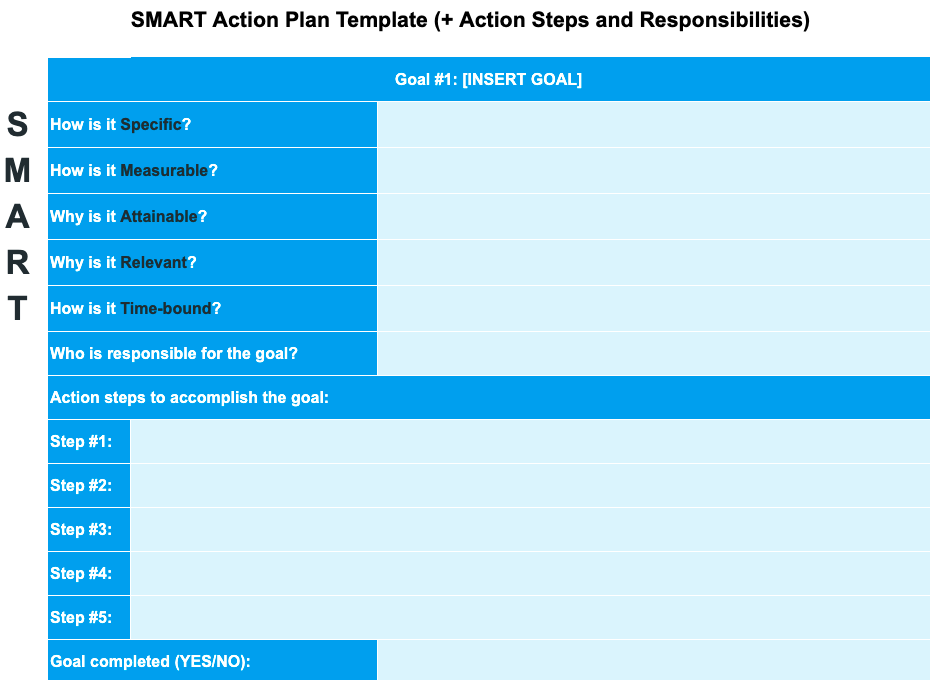
⬇️ Download the SMART Action Plan Template (+ Action Steps and Responsibilities) PDF
⬇️ Download the SMART Action Plan Template (+ Action Steps and Responsibilities) Google Docs
⬇️ Download the SMART Action Plan Template (+ Action Steps and Responsibilities) Excel
⬇️ Download the SMART Action Plan Template (+ Action Steps and Responsibilities) Google Sheets
New Year SMART Goal Template
The New Year SMART Goal Template prompts you to provide an overview of your personal and professional aspirations for the coming year.
As a result, this template goes above and beyond to explore which goals you truly want to pursue — or not.
The New Year SMART Goal Template requires that you make a bit of a long-term commitment.
What is the New Year SMART Goal Template about?
The New Year SMART Goal Template lets you define SMART goals for your:
- Personal growth,
- Health,
- Business life,
- Family and friends,
- Travels,
- Hobbies, and
- New purchases in the new year.
How to use the New Year SMART Goal Template?
As soon as you download your preferred format, answer the prompts in as much detail as possible.
For example, in the Personal growth section, you can list things such as “Start meditating every day for 30 minutes” or “Read 20 book pages daily” and go from there.
Who should use the New Year SMART Goal Template?
This template is perfect for carrying out your New Year’s resolutions. So, you can be a university student, a freelancer, or anyone else pursuing goals in the coming year.
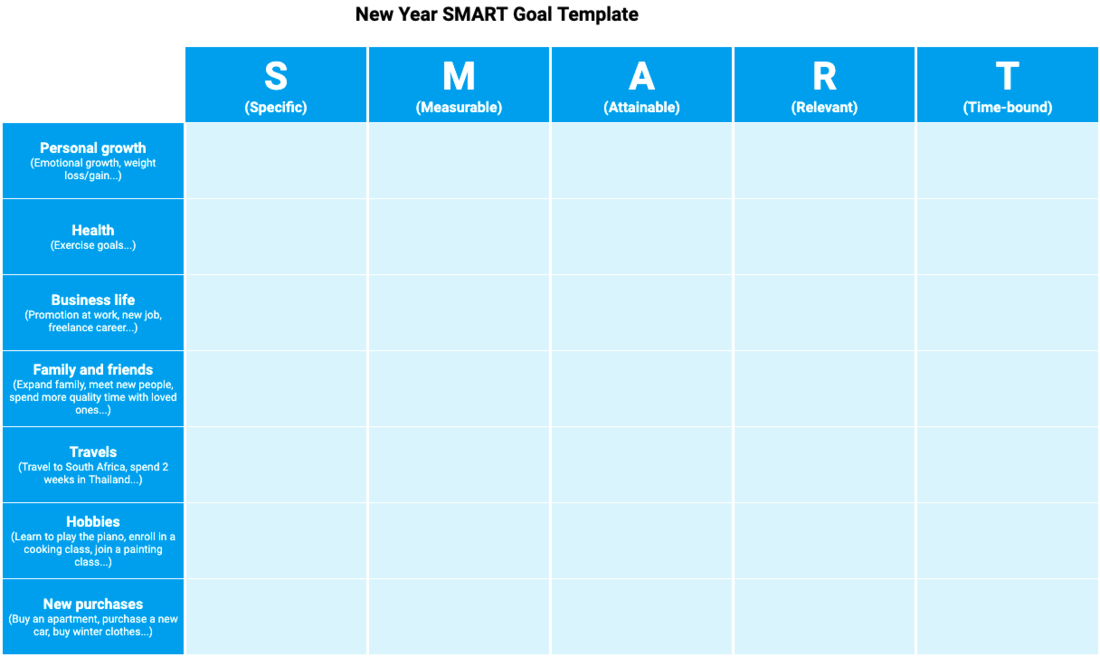
⬇️ Download the New Year SMART Goal Template PDF
⬇️ Download the New Year SMART Goal Template Google Docs
⬇️ Download the New Year SMART Goal Template Excel
⬇️ Download the New Year SMART Goal Template Google Sheets
SMART Goal Template for Project Managers
The SMART Goal Template for Project Managers is a clear, concise, and descriptive tool to get to the hows and whys of your project management goals.
In turn, it helps you lead your team and create a roadmap for success in a short period.
What is the SMART Goal Template for Project Managers about?
The SMART Goal Template for Project Managers consists of 5 sections.
With this template, you can assess each goal you want to assign to a team member. In fact, you can decide whether the goal needs redefining or even whether it’s worthwhile (or unattainable by the assigned team member) in the first place.
How to use the SMART Goal Template for Project Managers?
Answer 2 questions per section to set and define a goal any project manager might face. Similarly, remember that you can tinker with the details and rewrite anything you deem necessary at any point during the process.
Who should use the SMART Goal Template for Project Managers?
This SMART goal template is perfect for managers who are currently defining the goals and objectives of a project. You can also consider this template as a way to establish SMART goals for better time management.
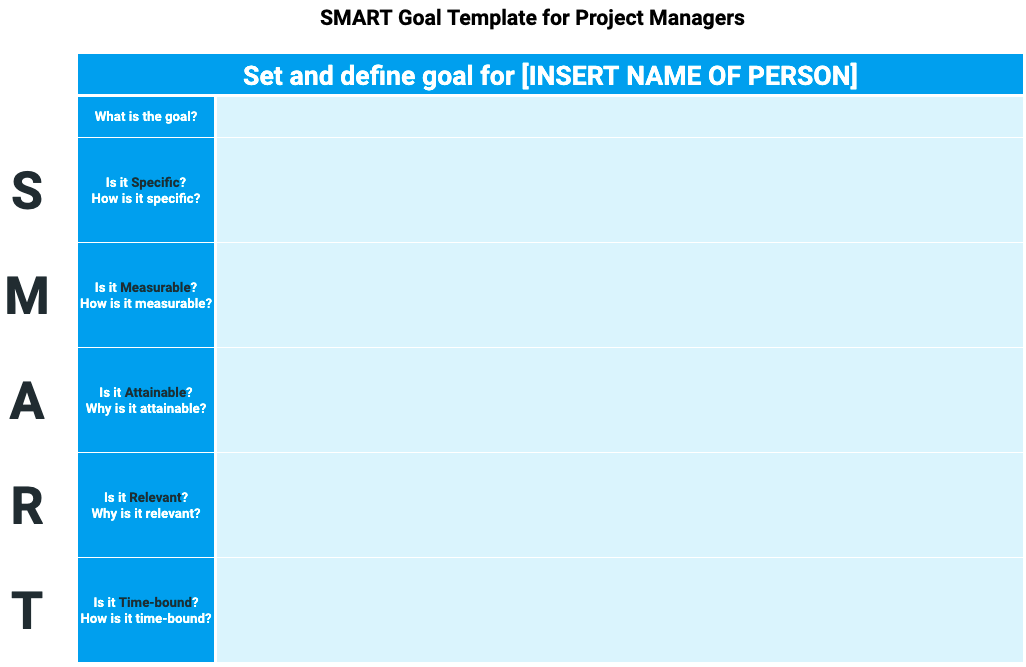
⬇️ Download the SMART Goal Template for Project Managers PDF
⬇️ Download the SMART Goal Template for Project Managers Google Docs
⬇️ Download the SMART Goal Template for Project Managers Excel
⬇️ Download the SMART Goal Template for Project Managers Google Sheets
SMART Goal Template (+ Rewards/Motivations)
Last but not least, the SMART Goal Template (+ Rewards/Motivations) presents a powerful tool for learning what motivates you to reach your goals.
By taking the time to understand what drives you, you can tap into your intrinsic motivation and stay focused on your short-term and long-term goals even when things get tough.
What is the SMART Goal Template (+ Rewards/Motivations) about?
The SMART Goal Template (+ Rewards/Motivations) lets you assess whether a goal is specific, measurable, attainable, relevant, and time-bound.
Then, you can define the motivations and rewards that stand behind your pursuit of the said goal.
How to use the SMART Goal Template (+ Rewards/Motivations)?
To get to the bottom of your rewards and motivations, simply respond to 5 questions from the SMART framework, followed by 2 questions on how you’ll make the goal motivating and rewarding.
Who should use the SMART Goal Template (+ Rewards/Motivations)?
Rewards are important to keep you motivated enough to pursue a goal. I suggest you pick this SMART goal template if you want to define specific rewards that await you when you reach a goal.
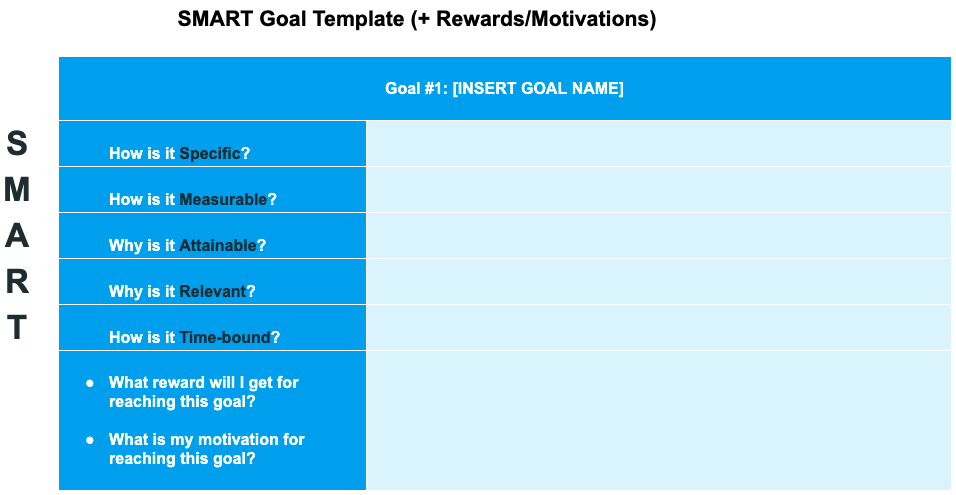
⬇️ Download the SMART Goal Template (+ Rewards/Motivations) PDF
⬇️ Download the SMART Goal Template (+ Rewards/Motivations) Google Docs
⬇️ Download the SMART Goal Template (+ Rewards/Motivations) Excel
⬇️ Download the SMART Goal Template (+ Rewards/Motivations) Google Sheets
Wrapping up: The SMART framework helps you reach goals faster
The SMART goal formula gives you an easy way to determine whether the goal you’re looking to pursue is:
- Specific,
- Measurable,
- Attainable, and
- Relevant enough for you to pursue it in the first place.
The SMART goal criteria also give you a time frame and deadline — the time-bound part in the acronym — to use as a point of reference for your plan as you work toward the said goal.
Above all, SMART goals criteria are suitable for both personal and business goals. Speaking of which, SMART goals help you:
- Improve performance at work,
- Lead teams more effectively,
- Enhance time management,
- Be healthier and fitter,
- Boost accountability, and much more.
Whatever SMART goal you pursue, it’s always best that you use a ready-made template or a goal tracking app to define and track it. If you do it, you’ll spend less time planning the goals and more time actually working on them.
✉️ How does your goal sound like after integrating the SMART goal criteria in it? Have you found a SMART goal template that works for your needs? Drop us a line at blogfeedback@clockify.me for a chance to be featured in this or one of our future articles. And, if you liked this blog post, share it with someone who might find it useful.





